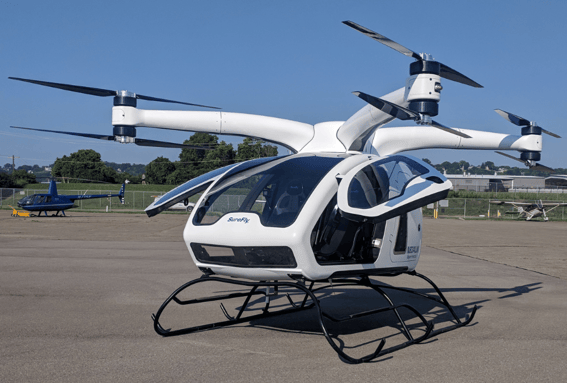The Capabilities of Composites
Though they may sound novel, composite materials have existed as long as the Earth’s oldest forests. Tree bark, and the wood drawn from it, is in fact a composite made of long cellulose fibers held together by lignin, a natural binding agent. Alone, both cellulose fibers and lignin are weak materials—together, they provide enough strength to support entire buildings. Although composites have existed in nature for hundreds of millions of years, man-made composites are relatively recent, dating as far back as 3000 B.C. when the ancient Egyptians developed mud-and-straw bricks.
From primitive civilizations and their tools to the bustling cities and innovations of today, composite materials have enabled engineers to create unique and advanced combinations of properties for varied and wondrous applications. Continuing developments in materials science have accelerated faster than ever before, creating new opportunities for engineers to innovate and bolstering the accelerated growth of a variety of industries from aviation to sports equipment.
Why composites?
The lure of composites is simple—they are capable of everything legacy metals are, at less weight and often with additional advantages. At first, these properties were related mostly to strength—combining two or more materials could overcome the shortcomings of the individual materials alone. In the case of primitive bricks, this meant enhancing the tensile strength of dried mud using straw, and reciprocally enhancing the compressive strength of straw using mud, delivering enough overall strength to hold up early residential structures. The same concept applies to newer and more widely known composites such as fiberglass, carbon fiber, and graphite materials. Each of these materials is composed of a cluster of fibers/fragments of strong reinforcement material bound together by a matrix material.

Advanced Properties
More recently, material science has evolved to be able to customize and specialize composite materials to meet stringent and advanced parameters for heat, magnetic, or electrical properties, as well as resistance to corrosion, vibration, and other environmental and functional factors. Creating a careful and deliberate combination of matrix and reinforcement materials can lend a product these specific set of properties. Matrix materials are typically polymers like resins or other plastics that are either a thermoset or thermoplastic—once cured, thermoset materials maintain their shape and rigidity even when subjected to extreme heat, whereas thermoplastic materials can be reshaped or remelted after having been cured. Both types of matrix materials have their own advantages and disadvantages, depending on their application, such as toughness, shelf life, toxicity, and capacity for recycling. The same applies to reinforcement materials, which have different mechanical properties that may be preferred depending on the use case.
For legacy materials like metals, many of the advanced and specific properties of composites are often difficult to compete with and sometimes impossible to replicate. With a growing number of technologies relying either heavily or completely on composites, it is clear—metal may have been the safe choice in the past, but composites are a sustainable and necessary investment into the present and future.

The Future is Built of Composites
Urban Air Mobility
The distant dream of flying cars is beginning to become a reality with eVTOL air-taxis. With ranges of 150-250 miles, eVTOL (electric vertical takeoff and landing) air taxi and cargo vehicles can carry 4-5 passengers or heavy loads within and between cities, completely on electric or hydrogen fuel cell power. Composite structures provide a number of benefits to these vehicles, including UV resistance, coatability for aesthetics and protection, and superior flammability resistance. A particularly relevant advantage composites is in damage identification. Most composites have a low elongation to fracture. Damage is usually easy to identify and repair or replace, whereas a more ductile material may yield and be incapable of carrying the same load without visible damage. While these additional properties are certainly helpful, eVTOL may not have been possible without composites because electric power doesn't yet have the power density to carry heavy loads without dedicating excessive space to battery storage. The lightweight nature of composites maximizes the payload of the eVTOL vehicle, enabling it to go farther, faster, for longer—and as it stands, long enough to make the business case for air taxis.
Aside from passenger air mobility, automated drones are also benefitting from composites. The same benefits as air taxis apply to these unmanned air vehicles (UAVs)—UV resistance, flame retardance, coatability, and damage identification. The stiffness of many composites is also a key feature for UAVs—the small aircraft encounter a great deal of air resistance which can cause vibration, but stiff materials help to reduce the level of this disruption and therefore help capture clearer and more stable data, whether it be from a sensor or a camera.
Recreation
High-performance sports equipment is typically built of composites for improved resistance to repeated impact and enhanced durability under harsh outdoor conditions. Carbon fiber dominates the sports composites market and is in high demand for bicycle frames, golf club shafts, fishing rods, tennis rackets, and other products requiring resistance against compressive forces as well as stability along their lateral sides. Fiberglass is also preferred by manufacturers of skis, snowboards, and hockey sticks.
Consumer firearms, particularly optics, see great benefits from use of composites. Similar to UAV applications, the superior stiffness and stability of composites results in improved resolution at longer distances when used for optics housings. Many other firearms accessories, such as magazine pulls, are also made of composites. Though some players in the firearms market have been slow to move, leading companies like Glock have been utilizing composites in their products for over two decades, cementing their lead over the competition.

Automotive
In the last few decades, racers have relied on carbon fiber wheels to get them further, faster, with the lightweight and stiff material getting them the few seconds’ advantage they need to win a race. In fact, NASCAR’s Generation 6 cars, which compete in its Cup Series, contain carbon fiber body panels as well as hood and rear deck lids made of carbon fiber with Kevlar incorporated. The Generation 7 “Next Gen” cars are set to incorporate even more composites, possibly boasting an all-composite body. NASCAR teams often turn to composites as a way to legally reduce weight as well as to take advantage of increased heat resistance, which protects from the tremendous heat generated by brakes, and decreased splintering and shattering, which becomes incredibly important in the event of a crash.
Away from the racetrack, automotive giants like BMW, Audi, Fiat, and more have used carbon fiber in both electric and non-electric vehicles. The material can be found in door panels, seatbacks, linings, and dashboard carriers, incorporated throughout for its for structural reinforcement and protection from crashes.
Aerospace and Defense
Increasing demand for fuel-efficient and lightweight aircraft is driving composite materials to become a foundational component of modern aviation. The same applies to space, where launch costs are calculated by the gram and each unit of weight savings is an opportunity to increase payload for advancement in space exploration. For the military, every ounce counts, and the durable, lightweight, and environmentally resistant nature of composite materials helps to lighten the load on the soldier and ensures their equipment lasts longer. Read more about how composites are paving the way for the future of aerospace, defense, and space by downloading Innovative Breakthroughs in Aerospace & Defense with Engineered Composites.
HX5®, Alpine Advanced Material’s flagship nanocomposite material, boasts both superior corrosion resistance and high UV resistance compared to 6061-T6 aluminum. This ultra-light and mechanically superior nanocomposite is designed to be the most capable, versatile and best-in-class option for high-performance installations.






